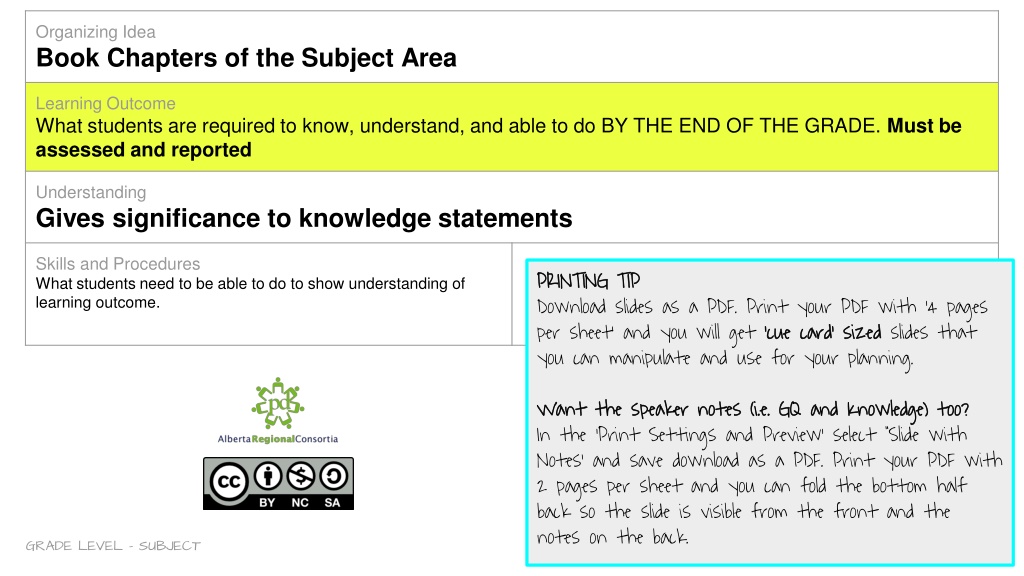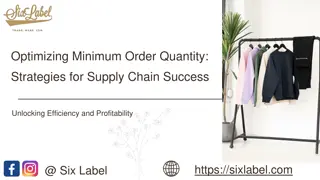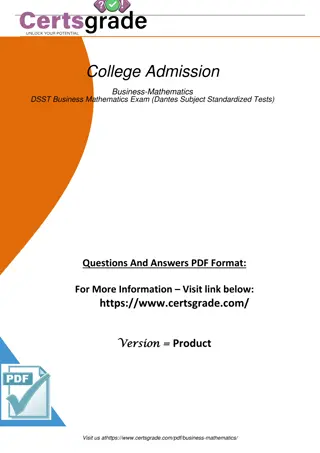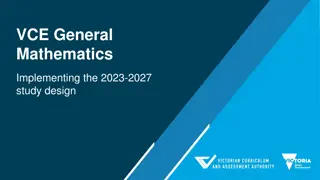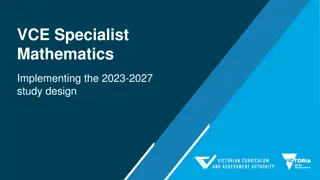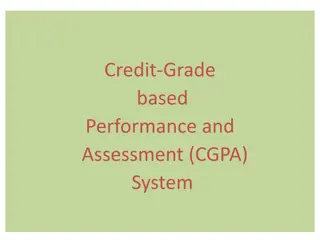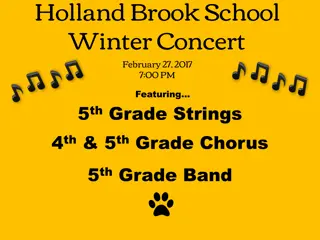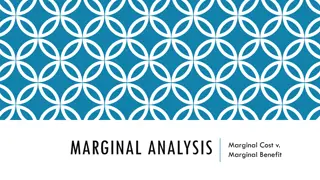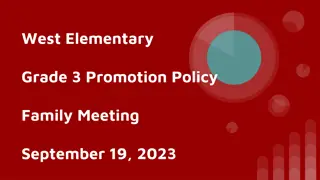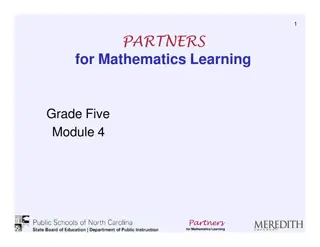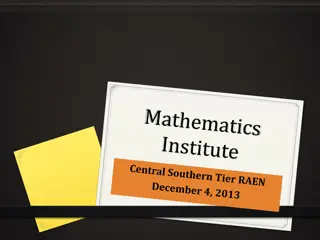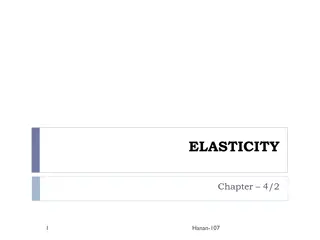Understanding Quantity Analysis in Grade Two Mathematics
Students in grade two are expected to analyze quantities up to 1000 by understanding natural numbers, place values, even/odd numbers, composition of groups, and estimation techniques. The curriculum emphasizes representing quantities, decomposing numbers, skip counting, modeling even and odd quantities, and estimating using benchmarks. By the end of the grade, students should be proficient in these skills and concepts, enabling them to interpret and manipulate numbers effectively.
Download Presentation

Please find below an Image/Link to download the presentation.
The content on the website is provided AS IS for your information and personal use only. It may not be sold, licensed, or shared on other websites without obtaining consent from the author. Download presentation by click this link. If you encounter any issues during the download, it is possible that the publisher has removed the file from their server.
E N D
Presentation Transcript
Organizing Idea Book Chapters of the Subject Area Learning Outcome What students are required to know, understand, and able to do BY THE END OF THE GRADE. Must be assessed and reported Understanding Gives significance to knowledge statements Skills and Procedures What students need to be able to do to show understanding of learning outcome. PRINTING TIP Download slides as a PDF. Print your PDF with 4 pages per sheet and you will get cue card sized you can manipulate and use for your planning. PRINTING TIP cue card sized slides that Want the speaker notes (i.e. GQ and Knowledge) too? In the Print Settings and Preview select Slide with Notes and save download as a PDF. Print your PDF with 2 pages per sheet and you can fold the bottom half back so the slide is visible from the front and the notes on the back. Want the speaker notes (i.e. GQ and Knowledge) too? UPDATED APRIL 2022 GRADE LEVEL - SUBJECT
Organizing Idea Number Learning Outcome Students analyze quantity to 1000. Understanding There are infinitely many natural numbers. Every digit in a natural number has a value based on its place. Each natural number is associated with exactly one point on the number line. Skills and Procedures Represent quantities using words and natural numbers. Identify the digits representing thousands, hundreds, tens, and ones based on place in a natural number. Relate a number, including zero, to its position on the number line. UPDATED APRIL 2022 GRADE TWO - MATH
Organizing Idea Number Learning Outcome Students analyze quantity to 1000. Understanding A quantity can be interpreted as a composition of groups. Skills and Procedures Decompose quantities into groups of 100s, 10s, and 1s. Skip count by 2s and 10s, starting at any number. Count within 1000, forward and backward by 1s, starting at any number. Determine the value of a collection of coins or bills of the same denomination by skip counting. Skip count by 20s, 25s, or 50s, starting at 0. UPDATED APRIL 2022 GRADE TWO - MATH
Organizing Idea Number Learning Outcome Students analyze quantity to 1000. Understanding All natural numbers are either even or odd. Skills and Procedures Model even and odd quantities by sharing and grouping. Describe a quantity as even or odd. Partition a set of objects by sharing or grouping, with or without remainders. UPDATED APRIL 2022 GRADE TWO - MATH
Organizing Idea Number Learning Outcome Students analyze quantity to 1000. Understanding A quantity can be estimated when an exact count is not needed. Skills and Procedures Estimate quantities using benchmarks UPDATED APRIL 2022 GRADE TWO - MATH
Organizing Idea Number Learning Outcome Students analyze quantity to 1000. Understanding Inequality is an imbalance between two quantities. Skills and Procedures Model equality and inequality between two quantities, including with a balance. Compare and order natural numbers. Describe a quantity as less than, greater than, or equal to another quantity. UPDATED APRIL 2022 GRADE TWO - MATH
Organizing Idea Number Learning Outcome Students investigate addition and subtraction within 100. Understanding A sum can be composed in multiple ways. Skills and Procedures Visualize 100 as a composition of multiples of 10 in various ways. Compose a sum in multiple ways, including with more than two addends. UPDATED APRIL 2022 GRADE TWO - MATH
Organizing Idea Number Learning Outcome Students investigate addition and subtraction within 100. Understanding Addition and subtraction can represent the sum or difference of countable quantities or measurable lengths. Determine a missing quantity in a sum or difference, within 100, in a variety of ways. Skills and Procedures Recall and apply addition number facts, with addends to 10, and related subtraction number facts. Solve problems using addition and subtraction of countable quantities or measurable lengths. Investigate strategies for addition and subtraction of two-digit numbers. Add and subtract numbers within 100. Verify a sum or difference using inverse operations. UPDATED APRIL 2022 GRADE TWO - MATH
Organizing Idea Number Learning Outcome Students interpret part-whole relationships using unit fractions. Understanding Fractions can represent part-to-whole relationships. One whole can be interpreted as a number of unit fractions. Model one whole, using a given unit fraction, limited to denominators of 10 or less. Skills and Procedures Model a unit fraction by partitioning a whole object or whole set into equal parts, limited to 10 or fewer equal parts. Compare different unit fractions of the same whole, limited to denominators of 10 or less. Compare the same unit fractions of different wholes, limited to denominators of 10 or less. UPDATED APRIL 2022 GRADE TWO - MATH
Organizing Idea Geometry Learning Outcome Students analyze and explain geometric attributes of shape. Understanding Shapes are defined according to geometric attributes. A shape can be visualized as a composition of other shapes. Skills and Procedures Sort shapes according to two geometric attributes and describe the sorting rule. Relate the faces of three-dimensional shapes to two-dimensional shapes. Create a picture or design with shapes from verbal instructions, visualization, or memory. UPDATED APRIL 2022 GRADE TWO - MATH
Organizing Idea Geometry Learning Outcome Students analyze and explain geometric attributes of shape. Understanding Geometric attributes do not change when a shape is translated, rotated, or reflected. Skills and Procedures Investigate translation, rotation, and reflection of two- and three- dimensional shapes. Describe geometric attributes of two- and three-dimensional shapes in various orientations. Recognize the translation, rotation, or reflection of shapes represented in artwork. UPDATED APRIL 2022 GRADE TWO - MATH
Organizing Idea Measurement Learning Outcome Students communicate length using units. Understanding Length is quantified by measurement. Length is measured with equal-sized units that themselves have length. The number of units required to measure a length is inversely related to the size of the unit. Compare measurements of the same length measured with different nonstandard units. Skills and Procedures Measure length with non-standard units by tiling, iterating, or using a self-created measuring tool. Measure length with standard units by tiling or iterating with a centimetre. Compare and order measurements of different lengths measured with the same non-standard units, and explain the choice of unit. Compare and order measurements of different lengths measured with centimetres. UPDATED APRIL 2022 GRADE TWO - MATH
Organizing Idea Measurement Learning Outcome Students communicate length using units. Understanding Length can be estimated when a measuring tool is not available. Skills and Procedures Identify referents for a centimetre. Estimate length by visualizing the iteration of a referent for a centimetre. Investigate First Nations, M tis, or Inuit use of the land in estimations of length. UPDATED APRIL 2022 GRADE TWO - MATH
Organizing Idea Pattern Learning Outcome Students explain and analyze patterns in a variety of contexts. Understanding A pattern can show increasing or decreasing change. A pattern is more evident when the elements are represented, organized, aligned, or oriented in familiar ways. Skills and Procedures Describe non-repeating patterns encountered in surroundings, including in art, architecture, cultural designs, and nature. Investigate patterns in a hundreds chart. Create and express growing patterns using sounds, objects, pictures, or actions. UPDATED APRIL 2022 GRADE TWO - MATH
Organizing Idea Pattern Learning Outcome Students explain and analyze patterns in a variety of contexts. Understanding A pattern core can vary in complexity. Skills and Procedures Create and express a repeating pattern with a pattern core of up to four elements that change by more than one attribute. UPDATED APRIL 2022 GRADE TWO - MATH
Organizing Idea Time Learning Outcome Students relate duration to time. Understanding Time can be communicated in various ways. Duration is the measure of an amount of time from beginning to end. Skills and Procedures Express significant events using calendar dates. Describe the duration between or until significant events using comparative language. Describe the duration of events using non-standard units. Relate First Nations winter counts to duration. UPDATED APRIL 2022 GRADE TWO - MATH
Organizing Idea Time Learning Outcome Students relate duration to time. Understanding Duration is quantified by measurement. Skills and Procedures Describe the relationship between days, weeks, months, and years. Describe the duration between or until significant events using standard units of time. UPDATED APRIL 2022 GRADE TWO - MATH
Organizing Idea Statistics Learning Outcome Students relate data to a variety of representations. Understanding Data can be collected to answer questions. Skills and Procedures Generate questions for a specific investigation within the learning environment. Collect first-hand data by questioning people within the learning environment. UPDATED APRIL 2022 GRADE TWO - MATH
Organizing Idea Statistics Learning Outcome Students relate data to a variety of representations. Understanding Data can be represented in various ways. Skills and Procedures Record data in a table. Construct graphs to represent data. Interpret graphs to answer questions. Compare the features of pictographs, dot plots, and bar graphs. UPDATED APRIL 2022 GRADE TWO - MATH
